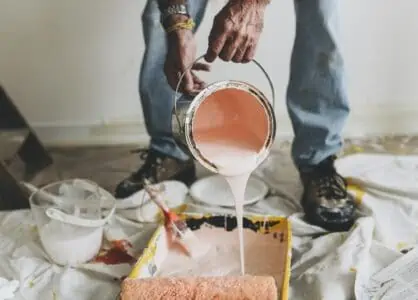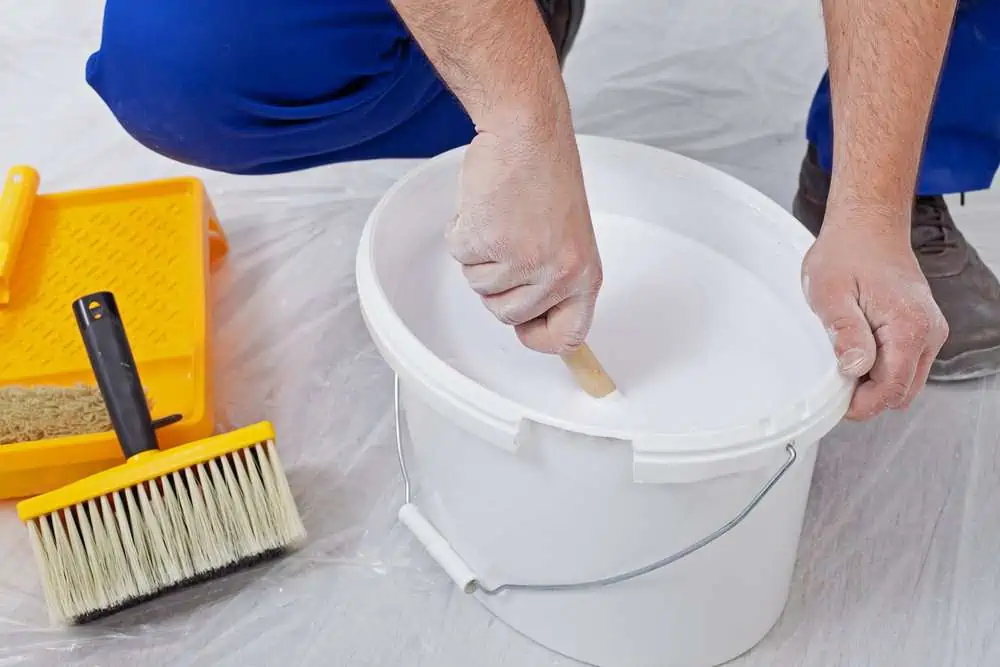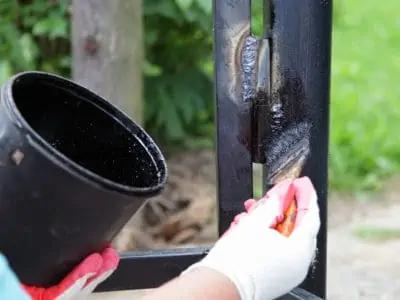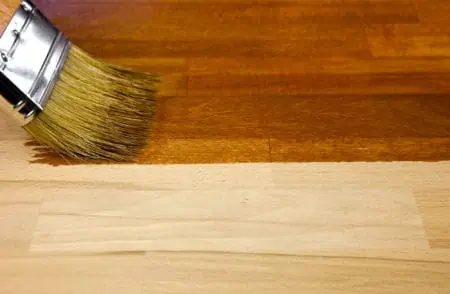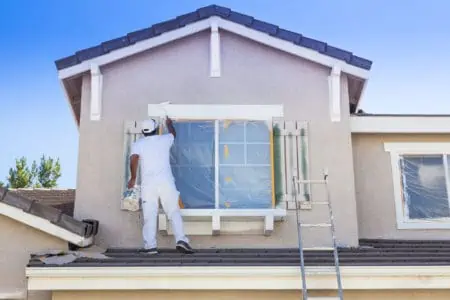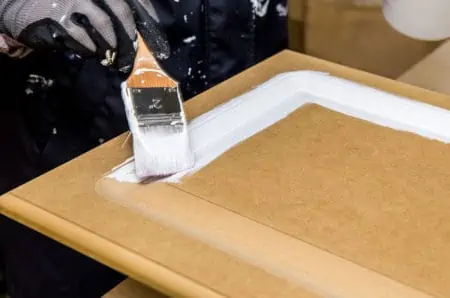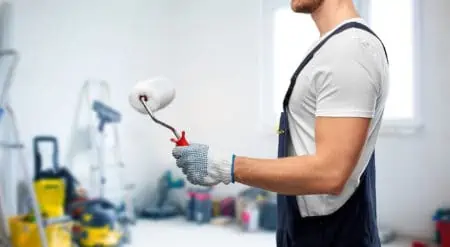Starting a painting project with latex paint, but the consistency is too thick for a proper application? Then it’s time to learn how to thin latex paint for a sprayer. The process is really simple, and all you need is one ingredient that you already have at home.
Key Takeaways
- Thin latex paint with water: Add half a cup of water per gallon of paint, stirring in small increments until desired consistency is reached.
- Test paint thickness: Stir the paint and check if it has a smooth, thick cream consistency. If not, add more water and stir again.
- Use a funnel to check consistency: If the paint flows easily through the funnel, it should work well with a sprayer.
- Strain and add to sprayer: Strain the paint and pour it into the sprayer reservoir, ensuring a clean, even application.
How to Test Thickness of Latex Paint
Before learning how to thin paint for a sprayer, you have to first determine if the paint needs thinning in the first place.
- Grab a screwdriver with a flat blade if your paint comes in a metal can.
- Wedge the tip of the screwdriver beneath the lid of the container.
- To break the vacuum seal, depress the handle of the screwdriver.
- Take the lid off the paint container as soon as you notice the seal has broken.
- Use a paint stick to stir the latex paint for between five and 10 minutes.
- Move the stir stick in an upward and downward spiral pattern as you stir the paint.
- Take note of the paint as it emerges from the paint stick.
- Carefully pull the stick out of the paint, then hold it above the paint can as you do so.
- If the paint that comes off the stick has the consistency of thick cream and is smooth, then it does not need to be thinned.
Top Tip
A thinning chart can help you quickly figure out what ratio you need for the product at hand.
How Much Water Do You Need to Thin Latex Paint?
The amount of water that must be added depends on the paint you’re using. Latex paint of a higher grade is thicker and, as a result, requires more water. Whereas latex paint of lesser quality is thinner and, as a result, requires less water.
Most latex paints on the market typically need 1/2 cup of water for each gallon. Add just a little water, start stirring, and add water gradually until the paint reaches the right consistency.
Put aside a half cup of water for each paint gallon that you intend to use in your project. The typical ratio is half a cup of water for each gallon of paint.
Take Note
Use room temperature water and be careful not to add all of the water at once, as it may damage the paint.
How to Thin Latex Paint for a Sprayer
The process is identical whether you’re thinning latex paint for a sprayer or for brushing. You can thin latex paint with water in a few simple steps.
What You’ll Need
- Bucket.
- Quality latex paint.
- Clean stirring stick.
- Water.
- Funnel.
- Ladle.
- Strainer.
- Quality paint sprayer.
1. Determining Water Amount
Adding water to latex paint makes it more sprayable. As mentioned earlier, you’ll need about half a cup of water (about four oz.) for each gallon of paint you need to thin.
Pro Tip
For larger paint jobs, moving the paint from the can into a larger bucket is best. This will provide more space to add water and thin the paint without overflowing.
2. Add Water
When you’ve moved the paint into a larger bucket, it’s time to add water. Make sure to add the water in small increments, slowly pouring it into the bucket. Pour water into the bucket and begin stirring with a stick.
Begin stirring the paint with a stick, making spiraling upward and downward motions. At regular intervals, take the paint stick out of the bucket and watch how the paint drips off and into the container below.
If the paint is clumpy and doesn’t have a creamy consistency that drips into the bucket, you need to add more water. Pull the stick out of the container each time you add more water to check the consistency.
3. Test with a Funnel
You can use a ladle to move the paint through the funnel. If it moves readily through your funnel, then it will also move freely through the nozzle of your sprayer. If it does not pass through the funnel easily, add a little more water until it reaches the desired consistency.
4. Add to Sprayer
Pass the paint through a strainer before pouring it into the sprayer reservoir. This will clear the nozzle of any debris that could potentially clog it.
Remove the cap from the reservoir and get the sprayer ready. Test spray a piece of cardboard or wood while keeping the nozzle at a distance of eight inches from it. It ought to be easy to apply the paint.
Important
If your project is painting furniture, you’ll need to use a latex primer. Consider semi-gloss or satin finish for painting furniture.
Thinning Latex Paint with Floetrol
Floetrol is an additive for acrylic and latex paints that is supposed to make the paints behave more like oil-based paint. This is accomplished by increasing the viscosity of the paint.
It makes it easier to get rid of brush marks, boosts coverage, and minimizes the amount of paint that must be thinned before use. Additionally, the paint is lubricated by this substance, which helps to reduce the amount of wear and tear on a spray gun.
Floetrol is simple to use. Just follow the instructions on the paint box and add the recommended amount (typically one pint per gallon) to your paint.
Floetrol may be used with any brand of acrylic or latex paint. So, whether it is used indoors or outdoors, you can continue to use the paints you prefer.
Tips For Spray Painting with Latex
Now that you know how to thin latex paint, it’s time to look at some tips that will lead you toward better painting results:
- Use quality latex paint from brands like Valspar, Behr, Sherwin-Williams, or Ben Moore.
- Buy or rent a good sprayer, like this option from Wagner.
- Use a paint sprayer of an appropriate size (a larger one for painting interior and exterior walls, a smaller one for smaller furniture pieces, etc.).
- Test the paint and the sprayer on a small surface before starting the project (a piece of cardboard will do).
- When adjusting the sprayer pressure, start with the lowest setting recommended by the paint manufacturer.
- Consider using an airless sprayer. They are good with thicker paints and can provide even paint coats.
- Always wear a face mask, eye goggles, and gloves when painting.
- Thin the paint outside for better ventilation. If you have to do it inside, open all doors and windows first.
FAQs
Bottom Line
Once you learn how to thin latex paint for a sprayer, you’re one step closer to completing an almost effortless painting project. While water-based paint doesn’t need thinning, latex paints have a thick consistency that’s often not compatible with a sprayer right out of the can.
